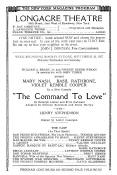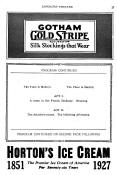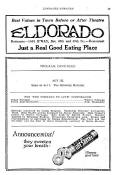The Command to Love
A comedy in three acts by Rudolph Lothar and Fritz Gottwald.
Adapted by Herman Bernstein and Brian Marlow. Opened at the Longacre Theatre, New
York City, September 20, 1927. After 247 performances the play went on national
tour for one year, with most of the New York cast. Produced by William A. Brady,
Jr. and Dwight Deere Wiman, in association with John Tuerk. Staged by Lester Lonegan.
|
Cast of Characters
|
Don Pedro Munaterra |
Thomas Louden |
|
The French Ambassador to Spain |
Henry Stephenson |
|
Marie-Anne |
Violet Kemble Cooper |
|
A Lackey |
Walter Colligan |
|
Gaston, Marquis du Saint-Lac |
Basil Rathbone |
|
Emile Ardillot |
Anthony Kemble Cooper |
|
Don Tomas Martinez |
Percy Hemus |
|
Manuela |
Mary Nash |
|
The Spanish War Minister |
Ferdinand Gottschalk |
|
The French Foreign Minister |
David Glassford |
|
|
|
| |
|
|
| |
|
| Act I — A Room in the French
Embassy in the evening, Madrid Act II — The
Attaché's Rooms, the following afternoon
Act III — A Room in the French
Embassy, the following morning |
 |
| Plot Summary:
"Gaston, with a reputation as the most successful of the modern Don Juans,
is drafted as an attaché of the French
embassy at the court of Spain. His unofficial duties include such social
contacts with the influential ladies of the court as will help his country.
Gaston, however, being true to his ambassador's wife, refuses to flirt until
the ambassador practically orders him to do so. Then he reluctantly but
successfully acknowledges the advances of Manuela, wife of the Spanish war
minister, and thus helps along the signing of a treaty the war minister
previously had opposed."1 |
From the playbill:
Stage Manager ....... Walter Colligan
Press Representative ....... Tom Weatherly
Settings conceived by Ouida Bergere. Technical Director: Livingston Platt.
Miss Nash's gowns designed by James Reynolds. Miss Cooper's gowns by Hattie
Carnegie. Sets built by Martin Turner. Scenery painted by Bergman Studios.
Brunswick Panatrope used. Screen and reproductions of paintings by Simka
Simmkhovitch. The Cock and the Toreador and the Bull by Hunt Diederich,
courtesy of Marie Sterner.
|
Below are two photos of scenes from the play. |
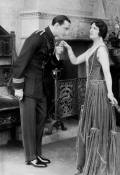
Basil Rathbone and Mary Nash
photo by White Studio |
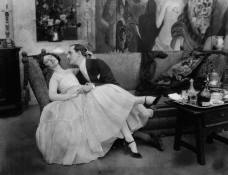
Basil Rathbone and Mary Nash
photo by White Studio |
Prior to opening on Broadway, The Command to Love tried out in
Stamford and Philadelphia. It opened at the Walnut Street Theatre in
Philadelphia on September 5, and was a great success, earning $15,000 the
second week. The following review from Variety is based
on the opening night performance in Philadelphia:
| Sophisticated comedy at its very best—and most daring—is to be found in
The Command to Love, a new comedy adapted from the Viennese of
Rudolph Lothar and Fritz Gottwald by Herman Bernstein and Brian Marlow. It
opened at the Walnut Street theatre last night.
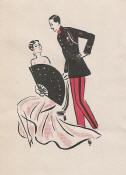 Frankly, it looks like a cinch that William Brady, Jr., and Deere Witman,
who present the piece in association with John Tuerk, have a winner. The
last two acts need hardly be touched. The first can be sharpened and snapped
up a little, but that won't take a week. Frankly, it looks like a cinch that William Brady, Jr., and Deere Witman,
who present the piece in association with John Tuerk, have a winner. The
last two acts need hardly be touched. The first can be sharpened and snapped
up a little, but that won't take a week.
The Command to Love will be all set to open on Broadway two weeks
hence. Being about the first of these polished, continental adaptations to
hit New York, it should score heavily.
It has one big advantage over some of the class plays of this type since
it appeals not only on account of its shrewd and sparkling writing, but also
through its hot love-making and snappy dialog with innuendos and suggestions
galore.
There is, however, nothing really offensive about the show. Not a trace
of crudeness or plain dirt.
A young attache to the French ambassador in Spain is involved in a love
affair with the wife of his boss, the ambassador.
Gaston, the young chap, is something of a rake and rounder, but the lady
is so jealous he is afraid to even show the slightest attention to another
woman. This get him in bad in court circles for, as the ambassador tells him
it is his duty to pay court, and philander and flirt. These things are as
necessary to a diplomat as his more serious and matters-of-fact duties.
Gossip eventually gets about that the reason for his aloof stands lies not
through desire but through inability.
Things reach such a state that Gaston is commanded by his superiors to
make love to the wife of the Spanish war minister, who is known to be
opposed to a certain treaty with France, and who is also known to be a
stubborn man to handle, except by his wife. Gaston hesitates; his beloved
says no, but his country calls and he obeys.
His path, however, is a perilous one, since it involves not only a jealous
woman, but two husbands, fondly unaware of their own wives indiscretions,
but capable of causing a lot of trouble if they find out.
The climax of the second act is reached when Gaston has prevailed upon
the war minister's wife, only to have the ambassador arrive, telling him
that he should break off the affair at once as it has been learned that the
war minister is shortly to be shorn of his power. This is one time, however,
that Gaston refuses to play the perfect diplomat. He insists that it is up
to him to be a gentleman first. Remarking that the lady is awaiting him in
the next room and probably counting the minutes, he dashes off. It is quite
obvious that he had found the paths of duty pleasant.
The Spanish war minister is not shorn of power after all, but is
persuaded to the treaty by his wife, and Gaston is congratulated for putting
across a fine diplomatic coupe-d'etat. As the ambassador remarks, his only
regret is that he cannot bestow upon him some medal or decoration. However,
Gaston's troubles are not over, as his now has two jealous women on his
hands, and in the end he is bound for Peru to get away from both.
The love scene of the second act between the young attache and the
minister's wife, interrupted a half dozen times, is both the laughing high
spot and the most daring portion of the performance.
The whole play is deft, delicate and sparkling. Some of its most risque
lines are so shrewdly expressed that they go over the heads of many, but
there is enough interest, laughs and smart innuendo that is understood to
make The Command to Love appeal to all.
The cast, expertly directed by Lester Lonegan, is topnotch. Not a flaw
in it. Basil Rathbone shows himself here as a light comedian and farceur and
he's just as sure and finished as in the emotional grimness of The
Captive. Mary Nash has the best role she's found in years, and does her
second act scene with delicious comedy sense, Violet Kemble Cooper,
ravishing in appearance, is ideally cast and scores. Ferdinand Gottschalk,
always dependable, is the war minister, a part just made for him. Henry
Stephenson is capital as the ambassador, also an important role. Anthony
Kemble Cooper clicks in a minor part.
This one looks sweet.
—Variety, 7 September 1927, p. 54
|
.
After the opening in Stamford, Connecticut, Variety noted that
despite torrential rain, there was a great turnout for the play, including
"such eminent Somebodies as Violet Heming, Carrol McComas,
Gladys Hansen, Katherine Alexander, Grace George, Peggy Wood, Florence Nash,
Mrs. Nash, William A. Brady, Sr., also . . . Ouida Bergere."
The Command to Love did big business in Stamford and
Philadelphia, and then opened on Broadway at the Longacre Theatre on
September 20. The Variety critic who reviewed the opening night
performance in New York was not overly thrilled with it.
Kisses!
Long, lingering osculatory smacks that reverberate to the back walls. And
pajamas! Gleaming red ones, worn by Mary Nash in a hot scene. And lines that
call a spade a spade, even if suggesting a trowel as they become plenty frank.
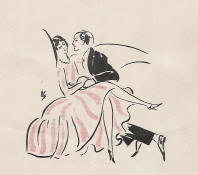 And sighs! Heavy, amorous sighs, emitted by Basil Rathbone as he "steams up"
two married women, not for love of the gals, but of country. The Marquis du
Saint-Lac is ordered to promote some heavy love-making to the wife of the
Spanish Minister of War. There's a treaty to be effected between France and
Spain, and all that is holding back matters is the signature of the Spanish war
head. He is obdurate, the one person able to sway him on all matters being
little wifey. So the French Ambassador offices his handsome aide to stress his
amours with the Spanish Minister's better half. Mary Nash plays the wife who
must be courted and won over. There are a couple of anxious moments for Miss
Nash—one as she drapes herself over Rathbone on a sofa and another when her
very dignity hinged on a single bright button of her red pajamas. And sighs! Heavy, amorous sighs, emitted by Basil Rathbone as he "steams up"
two married women, not for love of the gals, but of country. The Marquis du
Saint-Lac is ordered to promote some heavy love-making to the wife of the
Spanish Minister of War. There's a treaty to be effected between France and
Spain, and all that is holding back matters is the signature of the Spanish war
head. He is obdurate, the one person able to sway him on all matters being
little wifey. So the French Ambassador offices his handsome aide to stress his
amours with the Spanish Minister's better half. Mary Nash plays the wife who
must be courted and won over. There are a couple of anxious moments for Miss
Nash—one as she drapes herself over Rathbone on a sofa and another when her
very dignity hinged on a single bright button of her red pajamas.
It is the torrid love interest in this play that must bring its pull. The
love stuff is there all right, for the "fems" were sitting on the edge of
their seats with excitement opening night. Perhaps if the management switched
the general order to six matinees and one night weekly the show could go on
indefinitely. There is the dirt element to be considered, however, for "The
Command to Love" has more than plenty of it—bepowdered, if you will, but dirt.
The authors have not sought to make amends for their transgressions even at
the end, as the young swain for his "valiant" endeavors wins a coveted post in
Peru.
William A. Brady, Jr., Dwight Deere Wiman and John Tuerk have staged the play
adequately if inexpensively. More ornate accessories would have helped the
impressions while creating a better Spanish atmosphere. The playing is fairly
competent, Basil Rathbone and Miss Nash giving most of the histrionic momentum.
Henry Stephenson, Kemble Cooper and Ferdinand Gottschalk have done better work. The others fit in the
picture well.
The Command to Love ought to run along for 10 weeks, but hardly more.
—Variety, 28 September 1927, pp. 49, 52 |
Despite the lukewarm review, the play earned $18,000 in
its first week at the Longacre. The Command to Love continued to sell
out week after week, averaging more than $22,000 weekly. As of 1927, it was
the biggest success ever for the Longacre Theatre.2
Arthur Pollack, of The Brooklyn Daily Eagle, wrote a much more
favorable review.
A Footnote on Diplomacy
The Command to Love, Impudent Comedy at the Longacre Theater, Shows How a
Young Man Can Succeed if He Will Only Obey.
by Arthur PollockIt is a saucy comedy that came last night to the Longacre Theater, a comedy
about a young man who was shown his duty and did it. Droll stories of its kind
didn't use to be done in the American theater, the supposition being that plays
must be made for girls under 16 or for adults of like mentality. But the theater
has changed, or perhaps it is the girls. At any rate, youngsters should not take
their parents to this one. It is by Rudolph Lothar, the German dramatist who
wrote "The Werewolf," a premature pleast impropriety of several seasons back,
and Fritz Gottwald, Herman Bernstein and Brian Marlow have made the adaptation,
a neat and sober piece of work.
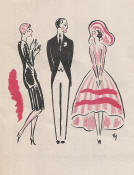 Few plays of the sort win such agreeable productions as this has been given.
Most often they are thrown upon the stage, a trifle fearfully, the producer
suspecting they may be quickly thrown off again and hesitating to spend the
money necessary to do them justice or hoping that their piquancy will cover all
the sins of inexpert staging. "The Command to Love" is staged as if it were the
most delicate philosophical comedy, is never permitted to grow ribald, is given
a demeanor most circumspect. It is very calm and suave and well bred, almost
inhibitive. For which reason, surely. "The Command to Love" risks persecution.
What, it will be asked, is our theater coming to when blue stories are told in a
manner so well bred? Things have reached a pretty pass when we cannot recognize
dirt by the soiled way in which it is done. And perhaps, true enough, this
Lothar comedy seems a little over-nice. Few plays of the sort win such agreeable productions as this has been given.
Most often they are thrown upon the stage, a trifle fearfully, the producer
suspecting they may be quickly thrown off again and hesitating to spend the
money necessary to do them justice or hoping that their piquancy will cover all
the sins of inexpert staging. "The Command to Love" is staged as if it were the
most delicate philosophical comedy, is never permitted to grow ribald, is given
a demeanor most circumspect. It is very calm and suave and well bred, almost
inhibitive. For which reason, surely. "The Command to Love" risks persecution.
What, it will be asked, is our theater coming to when blue stories are told in a
manner so well bred? Things have reached a pretty pass when we cannot recognize
dirt by the soiled way in which it is done. And perhaps, true enough, this
Lothar comedy seems a little over-nice.
The scenes are laid in the French Embassy in Madrid and the story discloses
the delicacies of Galliv diplomacy. The Spanish Minister of War, an honest
little fellow is opposed to the making of a certain treaty with France. The
French Ambassador is eager that the treaty be signed. He commands his young,
handsome and once expert attache to do what he can to bring the War Minister's
wife over to the French point of view. The young man's efforts provide a second
act in which the cause of France is saved by a smooth tongue, a sure technique
and a suit of pajamas. The attache's task is made difficult and therefore comic,
not so much by the need of craft in influencing the Minister's wife but by the
necessity for concealing from the Minister the nature of the influence being
brought to bear and concealing at the same time from hi, the attaches, superior,
the French Ambassador, the fact that he, the Ambassador, wears horns of exactly
the same king as the Minister. The young man is the lover of the Ambassador's
wife, an exceedingly watchful lady.
The situation calls for the greatest finesse. The attache proves that of the
most skillful diplomacy he is easy master, wins his spurs, in fact, wins also
the unqualified approval of the deceived husband.
Basil Rathbone, more animated than heretofore, plays the attache neatly.
Always an actor of commendable poise, he does not this time exaggerate the
poise. Mary Nash is the War Minister's wife, easily influenced, coy in a manner
none too Spanish. Many pleasant things are done by Ferdinand Gottschalk, Henry
Stephenson, Violet Kemble Cooper and Anthony Kemble Cooper. They have been
smoothly directed by Lester Lonergan.
The Command to Love is impudent and very graceful, too polite for those most
easily lured to theaters by the news that dirt is afoot, and hence somewhat
restricted in appeal. It will be liked chiefly by the friskier of those who look
well in evening dress.
—The Brooklyn Daily Eagle, Brooklyn, NY (21 Sept 1927), p.
34 |
More reviews:
"With the production of The Command to Love at the Longacre last
evening, one of those immortally brilliant comedies on a shameless theme
came to quicken the pulses of gourmet playgoers. It is swift, daring and
delightful." —J. Brooks Atkinson, New York Times
". . . as sedulously naughty a play as one ever sees in any land and age
was suavely, blandly, briskly performed at the Longacre, and there received
with unabashed hilarity." —Alexander Woollcott, Morning World
"The Command to Love is an impudently amusing comedy." —Alan Dale,
New York American
"The Command to Love is one of the delights of the present season.
You will find it a gay divertissement." —Robert Coleman, Daily Mirror
"The Command to Love is what we all have been impatiently waiting
for. It is genuine amusement. At present the best comedy in town." —Walter
Winchell, Evening Graphic
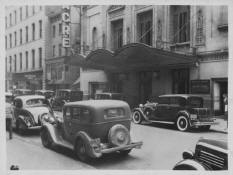
Longacre Theatre |
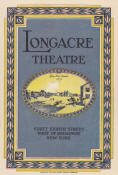
The Longacre Theatre playbill |
In early April 1928, after 247 performances, The Command to Love
closed at the Longacre Theatre. Almost immediately the play went on a
national tour, which began just up the street at the Shubert-Riviera theatre, Broadway at 97th St.,
the week beginning April 12. The play was performed at the Majestic Theatre, Brooklyn, NY,
from April 30 through May 2, 1928. Other cities on the national tour
included:
- Los Angeles (Belasco Theatre), May 21, 1928, for at least one week
(The cast: Mary Nash, Basil Rathbone, Violet Kemble Cooper, Henry Stephenson, Ferdinand Gottschalk, Anthony Kemble Cooper, Percy Hemus and T. Wigney Percival).
- San Francisco (Geary Theater). Beginning June 25 it played four weeks.
- Chicago (Studebaker Theatre) from September 2 through November 14, 1928. Percy Hemus
and David Glassford were not part of the cast in Chicago. Instead, there was
Herbert Ashton and T. Wigney Percival.
- Cincinnati (Shubert Theatre), November 28
- Cleveland (Hanna Theatre), December 12. During the engagement in
Cleveland, Rathbone was called back to New York. An actor named Tullio
Carminati took over Rathbone's role in the play.3
- Detroit (Lafayette Theatre), for two weeks, starting December 23.
|
 |
Because the play was successful, MGM began negotiating for the script to
make a film version of The Command to Love. In July 1928, however,
the Hays office announced that it didn't approve of a screen version of the
play, so MGM dropped the idea. Two years later, Variety reported that
Universal was working on a film version of the play, with Basil Rathbone in
the lead role.4 The film
would be called The Boudoir Diplomat. (The phrase "Boudoir Diplomat"
refers to a wealthy man who sleeps around.5
It's rather strange, therefore, that the Hays office did not object to the
new title.) A similar announcement appeared in Motion Picture News:
"Basil Rathbone has been signed by Universal to play the lead in
'The Boudoir Diplomat.' Mary Duncan has also been assigned an important role in
this talker which Mal St. Clair will direct. Rathbone appeared in the stage
version of the story which played in New York as 'The Command to Love.'"6
A short time later, Rathbone was out of the movie. Rumors and conflicting
reports concerning this event circulated:
- "Basil Rathbone, who played the lead on the stage, was in, but the
studio re-decided after tests." (Variety, August 6, 1930, p.
2)
- "Rathbone
recently walked out of the lead in 'Boudoir Diplomat' at Universal because of
story differences." (Variety, August 20, 1930, p. 61)
- Rathbone's "chief objection to the screen version of the part he
played in legit was that the thing had become a bedroom drama set in a
parlor." (Variety, August 13, 1930, p. 24)
Is it possible that Basil Rathbone flubbed his screen tests? It is more
likely that Rathbone objected to script changes. The Hays code had rules
forbidding passionate scenes as well as anything to suggest that sex outside
of marriage was acceptable.7 There must have been considerable
changes to the script of the play in order to pass the Hays censors. In its
brief review of The Boudoir Diplomat, Picture Play reported:
"Amusing play called 'The Command to Love' becomes dull and pretentious, and
why the more suggestive title? Ian Keith miscast as hero."8 One
can imagine Rathbone's outrage at seeing the script for The Command to
Love changed so drastically. But is that what really happened? A later
report suggests that Ouida was to blame:
Ouida's Advice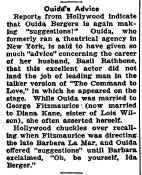 Reports from Hollywood indicate that Ouida Bergere is again making
"suggestions"! Ouida, who formerly ran a theatrical agency in New York, is said
to gave given so much "advice" concerning the career of her husband, Basil Rathbone, that this excellent actor did not land the job of leading man in the
talker version of "The Command to Love," in which he appeared on the stage.
While Ouida was married to George Fitzmaurice (now married to Diana Kane, sister
of Lois Wilson), she often asserted herself.
Hollywood chuckles over recalling when Fitzmaurice was directing the late
Barbara La Mar, and Ouida offered "suggestions" until Barbara exclaimed, "Oh, be
yourself, Ida Berger."
—Variety (10 September 1930) p. 53 |
Whether Ouida instigated the dissension or not, Basil apparently agreed
with her, and walked out on The Boudoir Diplomat. From Hollywood, he
went straight to New York to star in Arch Selwyn's play A Kiss of
Importance.
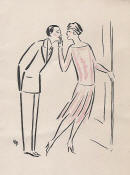 |
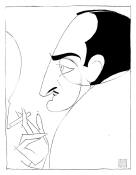
a Hirschfeld caricature of Rathbone in The
Command to Love |
Notes
- Burns Mantle, ed., The Best Plays of 1927-28 (Dodd, Mead and
Co., 1928), p. 410.
- Variety (9 November 1927),
p. 48.
- Variety (19 December 1928)
- "Rathbone's Role for U," Variety, July 30, 1930.
- Hal Erickson, Rovi, Review Summary,
www.nytimes.com/movies/movie/85770/The-Boudoir-Diplomat/overview
- "Rathbone in Stage Role" in Motion Picture News,
August 9, 1930.
- Marshall Cavendish, Sex and Society, Vol. 2 (Marshall Cavendish
Corp., 2010), p. 560.
- "A Confidential Guide to Current Releases," Picture Play (April
1931), p. 118.
|








